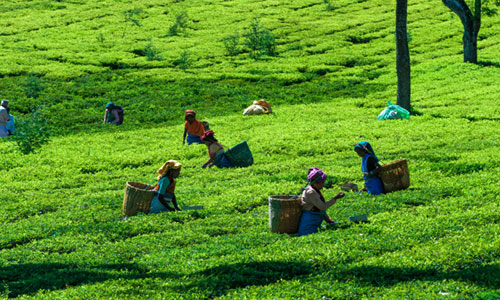Surprisingly, all tea varieties are produced from the same species & ndash; tea bush Camellia sinensis. But from several varieties obtained by natural and selective methods.
There are three varieties of tea bush in the world:
- Chinese & ndash; it includes Vietnamese, Chinese, Japanese, Georgian tea varieties, darjeeling;
- Assamese & ndash; it includes Ceylon, Indian, African tea varieties;
- Cambodian & ndash; mixture of the first and second types.
If we consider tea from a historical point of view, then, undoubtedly, China has the palm.
Tea trees were grown in China 5,000 years ago.
In India, tea production originated during the British colony, in the mid-19th century.
The idea succeeded and the tea caught on, but the terroir of India left its mark on all tea products, making them sharper and richer in taste, but less sophisticated in smell.
In terms of sales, India ranks second after China by a wide margin.
India is the leader in the export of black varieties, but China is famous for its green, white, yellow tea varieties, oolong and puers.
Nevertheless, China managed to produce decent black tea (in China black teas are called red), famous all over the world along with Indian Darjeeling or Assam.
For example, Tszyu Qu Hong Mei or Zhen Shan Xiao Zhong (Lapsang Sushong).
But the quality of Indian green teas remains at an average level & ndash; if you want a bright outstanding drink from unfermented tea leaves, then it is better to & nbsp; buy Chinese tea .

How is tea produced in India and China?
If in China a whole leaf is valued and among all varieties a whole large leaf at the top of the classification, then in India they prefer a granular form.
This is a medium quality tea, because not only the leaf gets into the granules, but often tea dust, which worsens the taste.
These are CTC teas. Their main advantage is the high caffeine content, which gives a strong rich infusion with a dense taste.
How do they drink tea in India and China?
The Chinese tea ceremony is known worldwide & ndash; it is a whole culture, accompanied by rituals and traditions.
In China, before drinking tea, calm thoughts, get rid of any negative emotions, cleanse the head and stomach & ndash; and only then are the slightest nuances of tastes and aromas recognized.
In India, for some time, tea products were produced only for export, and only in the middle of the 20th century, when an internal advertising campaign was launched in the country, the local population tasted tea.
But if in China this drink is drunk without sugar and other additives, enjoying all the versatility of a natural bouquet, then in India they drink a special masala tea.
Masala tea is a mixture of water and milk, to which sugar, salt and spices (cloves, nutmeg, cardamom, allspice) are added. Masala is boiled for 5-7 minutes on fire, and then insisted for another 10-20 minutes. Each Indian region has its own recipe for masala tea, and there are more than 200 of them in total.

Chinese tea at a traditional ceremony requires traditional tableware, including a full set of cups of different sizes, tongs, strainers, brushes, etc.
For beginners for tea drinking, you can only take chaban (tea board or table), gaiwan (brewing kettle), thermos, chahai (jug for draining water) and bowls.
You can buy original tea from China from our online store .
We only offer the best Indian and Chinese teas.
& laquo; Russian Tea Company & raquo; invites you to immerse yourself in a new world of bright tastes, unique exquisite smells and with nothing comparable to the pleasure that only truly high-quality tea gives.
